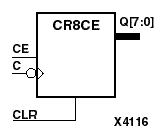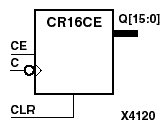|
|
|
|
|
|
| XC3000 | XC4000E | XC4000X | XC5200 | XC9000 | Spartan | SpartanXL | Spartan2 | Virtex |
|---|---|---|---|---|---|---|---|---|
| Macro | Macro | Macro | Macro | Macro | Macro | Macro | Macro | Macro |


CR8CE and CR16CE are 8-bit and 16-bit, cascadable, clearable, binary, ripple counters. The asynchronous clear (CLR), when High, overrides all other inputs and causes the Q outputs to go to logic level zero. The counter increments when the clock enable input (CE) is High during the High-to-Low clock (C) transition. The counter ignores clock transitions when CE is Low.
Larger counters can be created by connecting the last Q output (Q7 for CR8CE, Q15 for CR16CE) of the first stage to the clock input of the next stage. CLR and CE inputs are connected in parallel. The clock period is not affected by the overall length of a ripple counter. The overall clock-to-output propagation is n(tC - Q), where n is the number of stages and the time tC - Q is the C-to-Qz propagation delay of each stage.
The counter is asynchronously cleared, output Low, when power is applied. For CPLDs, the power-on condition can be simulated by applying a High-level pulse on the PRLD global net. FPGAs simulate power-on when global reset (GR) or global set/reset (GSR) is active. GR for XC3000 is active-Low. GR for XC5200 and GSR (XC4000, Spartans, Virtex) default to active-High but can be inverted by adding an inverter in front of the GR/GSR input of the STARTUP, STARTUP_SPARTAN2, or STARTUP_VIRTEX symbol.
| Inputs | Outputs | ||
|---|---|---|---|
| CLR | CE | C | Qz - Q0 |
| 1 | X | X | 0 |
| 0 | 0 | X | No Chg |
| 0 | 1 | Inc | |
| z = 7 for CR8CE; z = 15 for CR16CE. | |||